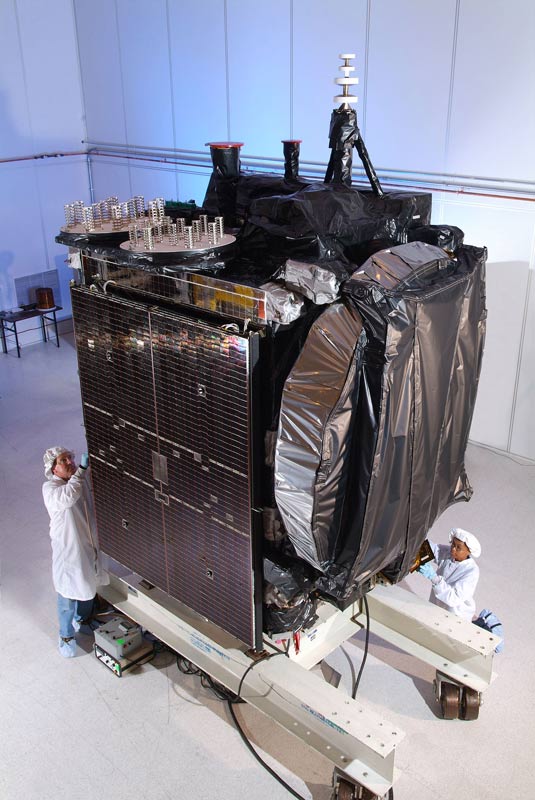Zombiesat! What's Next for the Out-of-Control Galaxy 15 Satellite

The Galaxy 15 commercial satellite that recently lostcontact with the ground has joined the ranks of a boatload of other debrisadrift in space. It's now termed a "zombiesat" by engineers who havea better sense of humor than you might have imagined.
So what's next for this 4,171-pound (1,892-kg) zombiesat?
This defunct satellite will probably drift to one of two"gravity wells" that catch most out-of-control spacecraft, expertssay.
Galaxy 15 could threaten nearby satellites because itscommunications package isstuck on and it may start interfering with its neighbors by siphoning offtheir signals. It's the first time such an event has ever occurred, and it sentOrbitalSciences, the satellite's builder, on a dash to figure out how to stop thesatellite-run-amok.
Galaxy 15, like many communications satellites, was circlingEarth about 22,369 miles (36,000 km) high in what's calledgeosynchronous orbit, meaning that it orbited at the same speed the Earthrotates, so that it sat perched above the same part of Earth all the time.
"There are two points in geosynchronous orbit calledgeopotential wells," explained Nicholas Johnson, chief scientist forOrbital Debris at NASA's Johnson Space Center in Houston. "These areperturbations in Earth's gravity field. Typically when satellites lose control theywill drift toward the nearest geopotential well and just oscillate around it."
The two spots, also called libration points, are located atlongitudes of 105 degrees west and 75 degrees east. There are already between 150and 200 objects oscillating around these points, Johnson said.
Get the Space.com Newsletter
Breaking space news, the latest updates on rocket launches, skywatching events and more!
Still a large place
In that sense, the new zombiesat doesn't significantlyincrease the spacedebris problem or pose a serious risk of colliding with an operationalsatellite.
"Space is still a very large place," Johnson toldSPACE.com. "There are a lot of objects that are drifting back and forth.Galaxy 15 really just kind of joins a relatively large number of objects ? it'snot a significant new hazard from a global standpoint. But if your satellitehappens to be near where Galaxy 15 is drifting then it's of more concern."
Eventually, everything in low-Earth orbit will eventuallyfall back down toward Earth because of atmospheric drag. The small amount ofatmospheric particles in space create friction with spacecraft, causing theirorbits to decay. The time it takes for an object's orbit to decay depends onits altitude.
For example, the InternationalSpace Station orbits at about 250 miles (400 kilometers) above Earth, whilethe Hubble Space Telescope circles much higher, at 353 miles (569 km).
"When things fall off the International Space Station, theytypically fall back within a couple months, but where Hubble is, it typically takesseveral years to fall back to Earth," Johnson said. "At 800 km you'retalking many decades or even hundreds of years."
To prevent the buildup of dead spacecraft in heavilytrafficked areas of geosynchronous orbit, guidelines recommend that when asatellite reaches the end of its life it is boosted to a higher orbit out ofthe way. This "graveyard orbit" is about 186 miles (300 km) abovewhere most satellites orbit.
"The whole idea is to get to an altitude so they don?tdrift back into the operational region for a very, very long time ? over 100years," Johnson said.
It's actually easier to boost a spacecraft up just this muchhigher than to maneuver a craft down to where it would immediately fall back toEarth and burn up in the atmosphere, he said.
Getting rid of space junk
To actually go and collect defunct spacecraft to remove the collision riskaltogether is currently beyond our ability.
"Unfortunately we haven't found a concept which appearsto be both technically feasible and affordable," Johnson said.
The best way to remove spent rocket stages and other largeobjects from orbit is to simply send up another spacecraft to rendezvous anddock with it and drag it back down to earth. This method would be extremelyexpensive and time-consuming, and isn't viable for the vast number of objects alreadyin space.
Some more exotic measures involving tethers and other propshave been proposed, Johnson said, but aren't yet feasible.
For getting rid of very small pieces of space junk, thereare two favorite ideas, he said. One involves shooting lasers at the objects topush them into lower-altitude orbits so they fall back down to Earth morequickly.
"That has technical, economic, as well as policyissues," Johnson said.
Another concept is to fly up a structure with a large areabut low mass so that when particles strike the surface they will penetrate andlose some of their orbital energy, causing them to fall back to Earth morequickly. This option would also need many technical issues ironed out.
"If it was easy we'd already be doing it," Johnsonsaid of tackling the debris problem. "But it's prudent to be working theissue now before it becomes a serious impediment to space operations."
- HowMuch Junk is in Space?
- Worst Space Debris Moments in History
- Images - Spotting Satellites and Spaceships From Earth
Join our Space Forums to keep talking space on the latest missions, night sky and more! And if you have a news tip, correction or comment, let us know at: community@space.com.

Clara Moskowitz is a science and space writer who joined the Space.com team in 2008 and served as Assistant Managing Editor from 2011 to 2013. Clara has a bachelor's degree in astronomy and physics from Wesleyan University, and a graduate certificate in science writing from the University of California, Santa Cruz. She covers everything from astronomy to human spaceflight and once aced a NASTAR suborbital spaceflight training program for space missions. Clara is currently Associate Editor of Scientific American. To see her latest project is, follow Clara on Twitter.









